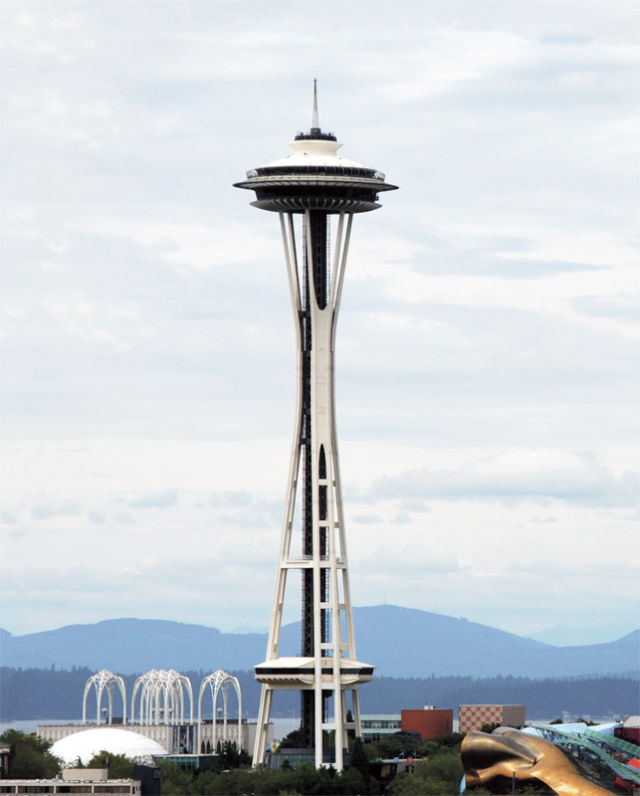The Space Needle: Seattle’s Inspired Icon

Image: Brian Gallatin
THERE IS A CURIOUS LEAPFROG arc that shapes the way we look at our cultural icons. One generation’s treasure morphs into the turkey of the next, to be showered with scorn: the Victorian home, the claw-foot tub, the ’59 Cadillac. But then the grandchildren’s generation discovers it, organizing preservation societies and shouting astronomical auction bids. This cycle parallels our natural tendency to rebel against the values of our parents while nostalgically embracing those of our grandparents.
The Space Needle, opened for business 50 years ago this month, as the exclamation mark of the Seattle World’s Fair, teeters precariously on the cusp of kitsch. But it never descended through the scorn phase (aside from a scatter of wayward dissenters such as Jonathan Raban, who wrote 20 years ago that living in view of it was “rather like having to put up with a black-velvet portrait of Jesus on one’s living room wall”). Even if we pointed it out to visitors with a joke line—“Behold, our municipal lawn ornament”—it was with affection, never derision.
What other twentieth-century artifacts have served North American cities as well? I think just three: the Empire State Building, the Golden Gate Bridge, and St. Louis’s Gateway Arch. The Space Needle’s imitators—San Antonio’s Tower of the Americas, Las Vegas’s Stratosphere Tower, the Calgary Tower—are more curios than icons.
The reason for the difference is fundamental: dramatic, graceful design. What we might call Architecture Power.
It’s inexplicable, an accidental alignment of muses or planets, that the Space Needle turned out as fine as it did. The circumstances of its conception pointed toward a cartoon or even a debacle. It was designed by committee. And very quickly. It migrated from napkin sketch to engineering blueprints in two years, and from a hole in the ground to opening day in under 11 months. By contrast, architect Eero Saarinen spent eight years perfecting the design of the Gateway Arch, and its construction then took 33 months.
If nothing else, the Space Needle’s story shows us that there is no one ideal way to design a monument. Eddie Carlson, a Seattle hotel man and civic booster, made a trip to Stuttgart, Germany, in 1959 and had a dinner in the barrel-shaped restaurant at the top of the chimneylike 350-foot Stuttgart Tower. Carlson was spearheading plans for the World’s Fair and, in a moment of inspiration, he doodled a sketch for a corresponding restaurant-on-a-stick for Seattle. Back home Carlson approached architect John Graham Jr. with the wild notion. Graham jumped on board and injected an ominous undercurrent of commercial kitsch: “Let’s make the restaurant revolve.”
It’s unlikely that Graham could have come up with a successful design for the Space Needle on his own. He was a second-generation architect, highly respected and successful, but most everything else out of his office wore a generic business suit—see the 901 Fifth Avenue building and the Decatur condos at Boren and Spring. But Graham engaged several of the architects in his own office in the conceptual design work, and most importantly brought in Victor Steinbrueck from the University of Washington to consult. According to official accounts, it was Steinbrueck who hit on the idea of the slender tripod legs subtly tapering to a stylishly pinched waist, then splaying dramatically out to support the crown, like a waiter balancing a tray on fingertips. A drawing from Graham’s office dated August 24, 1960, depicts the Needle in something approaching its final form—and it’s signed by Steinbrueck.
Additions since 1962 have compounded the design-by-committee amalgamation of the tower. John Graham and Company added the so-called Skyline Level including two banquet rooms in 1982, and Callison Architecture inserted the two-story base pavilion in 2000. Steinbrueck, never a terrific friend of developers’ interests in Seattle, criticized the Skyline addition, which he was not involved in: “I think it’s offensive aesthetically…to change the profile just to make a few more bucks,” he said. Practically any architect would respond likewise to postpartum alterations of his most famous baby, but in a coldly objective light, I see no havoc wrought by the addition. In fact, it ties the tripod legs together with a reassuring mass, making the entire structure seem more substantial. The base pavilion—also an addition to make a few more bucks, as it encloses a sprawling gift shop—mostly does no harm, except for the rain porch projecting off the ticket booth. In the context of the Space Needle’s sophisticated aspirations, this detail looks as afterthoughty as a weekend handyman’s carport.
SO WHAT MAKES the Space Needle work?
First, a touch of the same quality that Gustave Eiffel invested in his landmark tower: spidery delicacy. The steel legs are relatively slender, with slots between each pair that visually lighten the structure. Mentally plug the slots with concrete or study a photo of Las Vegas’s Stratosphere Tower and you see how more mass translates into clunkiness. Thank John Graham Jr. According to historian Murray Morgan’s account, he was the force who insisted on open steel legs instead of concrete.
The legs’ subtle curves are essential. Straight lines, as in a photographer’s tripod, would have killed any aspiration to grace. The Space Needle would have come off as an oil derrick spearing a Frisbee, a gangly enlargement of a kid’s Erector Set essay. Thank Bob LeBlanc of Pacific Car and Foundry (now Paccar). He figured out a seat-of-the-pants technique for bending the immense I-beams: heating pie-shaped sections of the beams so the hot side would shrink more as it cooled while the other side did not.
Run your eyes critically up these legs and you see a few scabs inflicted by the project’s haste. The backing plates at the crossbars look like bolted-on Band-Aids. The bends just above and below the waist aren’t as mathematically pure and organic as Saarinen’s arch, which mimics a mannerism of nature—the catenary curve of a chain hanging between two fixed points. It’s instructive to consider the construction costs of the two monuments, both built in the early ’60s and both just over 600 feet high: $4.5 million for the Needle, $13 million for the Arch.
In Robert Spector’s official Space Needle history, it was Graham who insisted on flattening the disc at the top and actually uttered the words “…more like a flying saucer.” And for sure, that’s what it became. The Space Needle’s cap borrowed shamelessly from 1950s alien-spacecraft fantasies—see especially the saucer from the 1956 MGM classic Forbidden Planet—and added Streamline Moderne kitchen-appliance ornamentation. The result is a visitor from the planet Rococo, but the radiating fins and halo appear nicely integrated, not gratuitous.
In the coldly objective light of the twenty-first century—we know we aren’t being visited by flying saucers, don’t we?—the disc looks a little frivolous, an imagined artifact of a future that never was. But the imagery of the trinket at the top almost doesn’t matter because the gesture of lofting it up there is so dramatic. The power is in Steinbrueck’s legs. Walk around and ponder the big lawn ornament from different vantages—the Seattle Center grounds, the Bainbridge ferry, Queen Anne’s Kerry Park—and you begin to understand: The Space Needle is more verb than noun.
The Needle’s dialogue with the sprawling blob at its feet, the Experience Music Project, is telling. The Needle celebrates engineering virtuosity, real and imaginary. EMP embodies the opposite: the consummate meltdown of rules, physical and cultural. The Space Needle is order, EMP is chaos. One reaches for the stars, the other reaches for the mushrooms. The Space Needle was designed by guys from Seattle, EMP by a California import, and the differential in values couldn’t be more obvious. It’s impossible to know exactly how the Seattle of 50 years from now will view these two neighboring icons, but here’s my wager: The Space Needle will remain Seattle’s secular cathedral spire, a symbol of values that are noble even when they’ve come to seem a little quaint. EMP will be a goofball field trip for architecture students.
The Swiss philosopher Alain de Botton has written, “It is architecture’s task to render vivid to us who we might ideally be.” Few buildings in Seattle or anywhere pass that bar. The Space Needle does. It has endured as it was conceived: heroic, exuberant, a symbol of Seattle’s and America’s ambition and optimism. What’s left now is for us to live up to it.
Don’t miss our slideshow to see how the Space Needle compares to other cities’ famous monuments.




